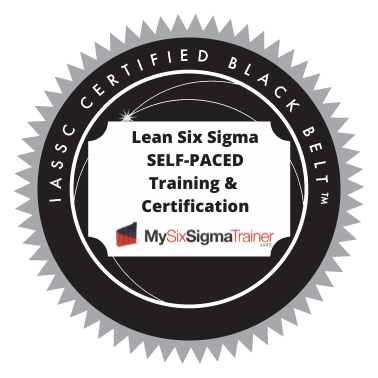
My Six Sigma Trainer
Lean Six Sigma Black Belt Certification
CLSSBB | IASSC Exam Certification Online Training - Lean Six Sigma Black Belt
With Lean Six Sigma you can learn how to identity problems in your process and how to improve productivity & results. A “Belt” signifies experience. Practitioners are given a “Belt” title (Black Belt, Green Belt, Yellow Belt) that corresponds to their level of experience.


Options available during checkout
EXAM CERTIFICATION
IASSC EXAM Certification with PeopleCert [includes $25 processing fee] +$475
Mock Lean Six Sigma Project +$600
FULL CERTIFICATION
Pass our comprehensive final exam
and submit a successful personal project
within 6 months +$750
- No PREQUISITES - includes YB & GB
- Learn Basic to Advanced Tools
- Program Length 140 hrs
[can be done in 6 hours per week for 24 weeks or 6 months]. This time includes assigned reading, videos lessons, exercises, quizzes, assignments, comprehensive final exam, practice exam for IASSC certification. - Black Belt ...is best suited for senior career professionals or consultants. Black Belts Lead Lean Six Sigma projects full time.
- Includes Student Manual - Your notes are already done for you!
- Includes graded exercises and assignments that are submitted with feedback from our Certified Master Black Belt instructors. Plus answers to questions [unlimited] submitted though learning portal.
- Get a feel for the official IASSC Exam. Practice with the IASSC mock exam +$129
- Get the IASSC Certification by passing the IASSC Certification Exam with PeopleCert [includes $25 processing fee]. Pay now ... request your voucher when you complete the course. Expires one year after issuance. +$475.
- Get the Holbus Training Group Certificate of Completion when you pass our comprehensive open book final. Take as many times as you would like then request your certificate when you are ready. Submit a successful Project to get full certification +$750
- Learn Anywhere! Courses are 100% online & 100% Self Paced.
- Take as long as you need to complete the course. You have 12 Months access to our E-learning portal.
- Include Soft Skills Training - Project Management Fundamentals & Top Soft Skills for Leaders
- EXPERIENTIAL LEARNING: Bring it all together with a Capstone Simulation of a real life Lean Six Sigma Case Study [Mock Project]. Includes deliverables, templates, essay for a simple but complete Lean Six Sigma project that is graded and feedback provided by Certified Master Black Belt Instructors +$600
- Project Coaching/mentorship available for individuals & corporate teams [Call for price]
- Minitab or SigmaXL statistical software is required to complete the course. Trial versions are available at each respective websites.
- PAYMENT PLANS AVAILABLE
Includes
Green Belt Content
Certified Lean Six Sigma Black Belt Certification
The IASSC Certified Lean Six Sigma Black Belt Certification (ICBB) is a professional who is well versed in the Lean Six Sigma Methodology, who leads improvement projects, typically in a full-time role. A Lean Six Sigma Black Belt Certification possesses a thorough understanding of all aspects within the phases of D-M-A-I-C. They understand how to perform and interpret Six Sigma tools and how to use standard principles of Lean.

Certification Testing
///////////////////////
The IASSC Certified Lean Six Sigma Black Belt Certification (ICBB) Exam is a 4 hour 150 question, closed book, proctored exam based on the IASSC Universally Accepted Lean Six Sigma Body of Knowledge for Black Belt Certifications. The Exam contains approximately 30 multiple-choice and true/false questions from each major section of the ILSSBOK for Black Belt Certifications and is administered in more than 8,000 Testing Centers located within 165 countries throughout the world.
Certification Testing
///////////////////////
The IASSC Certified Lean Six Sigma Black Belt Certification (ICBB) Exam is a 4 hour 150 question, closed book, proctored exam based on the IASSC Universally Accepted Lean Six Sigma Body of Knowledge for Black Belt Certifications. The Exam contains approximately 30 multiple-choice and true/false questions from each major section of the ILSSBOK for Black Belt Certifications and is administered in more than 8,000 Testing Centers located within 165 countries throughout the world.


Requirements
///////////////////////
In order to achieve the professional designation of IASSC Certified Black Belt Certification (ICBB) from the International Association for Six Sigma Certification candidates must sit for the IASSC Certified Lean Six Sigma Black Belt Certification Exam and achieve a minimum score of 580 points out of a total potential of 750 points.
There are no prerequisites required in order to sit for the IASSC Certified Lean Six Sigma Black Belt Certification Exam. For more about this see FAQ’s and the IASSC position on knowledge and application.
Purchase of a Black Belt Certification Exam Voucher when you sign up for your training.

Preparations
///////////////////////
For those who wish to sit for the exam it is recommended, but not required, that Lean Six Sigma training is obtained through a qualified institution, Lean Six Sigma trainer or corporate program. It is also recommended, although not required, that those sitting for the exam have some degree of real-world Lean Six Sigma work experience and project application experience.
Preparations
///////////////////////
For those who wish to sit for the exam it is recommended, but not required, that Lean Six Sigma training is obtained through a qualified institution, Lean Six Sigma trainer or corporate program. It is also recommended, although not required, that those sitting for the exam have some degree of real-world Lean Six Sigma work experience and project application experience.


Certification
///////////////////////
Upon successful achievement Professionals will receive a Certificate, suitable for framing, issued by the International Association for Six Sigma Certification or its designated Examination Institute, PeopleCert. Professionals will also receive IASSC Marks and the IASSC Marks Usage Policy which may be used on public profiles such as LinkedIn. Professionals may use the designation ICBB, IASSC Certified Black Belt Certification or any approved variation of the designation after their name in accordance with the IASSC Marks Usage Policy.

Lean Six Sigma Body of Knowledge
The IASSC Universally Accepted Lean Six Sigma Body of Knowledge (ILSSBOK) is an embodiment of the consensus of what industry expects of a Lean Six Sigma Black Belt Certification, Lean Six Sigma Green Belt and a Lean Six Sigma Yellow Belt.
The ILSSBOK is the result of research that was conducted over a two year period with the assistance of the leading industry publication house. The goal of this project was to characterize the standard knowledge requirements that are universally expected of a Lean Six Sigma Black Belt Certification, Lean Six Sigma Green Belt and a Lean Six Sigma Yellow Belt. With input from 1000’s of Deployment Leaders, Master Blacks Belts, Black Belt Certifications and Green Belts from 100’s of companies and industry sectors the ILSSBOK is truly the Voice of the Industry.
This is a significant breakthrough, for the first time in the history of the Lean Six Sigma the industry itself has defined what it deems is as a relevant and practical version of the knowledge expectations of a Lean Six Sigma Black Belt Certification, Green Belt and Yellow Belt. Today, IASSC continues this research and accepts ongoing industry feedback to ensure the standards continue to accurately represent the market expectations.
The ILSSBOK consists of five primary sections each of which is broken into sub-categories. This Body of Knowledge serves as the basis for what many of today’s leading Lean Six Sigma companies consider to be standard and expected knowledge requirements of a Lean Six Sigma Black Belt Certification, Lean Six Sigma Green Belt and Lean Six Sigma Yellow Belt. This body of knowledge also serves as the foundation upon which IASSC Certification examinations are built.
The IASSC Certified Black Belt Certification Exam is constructed based on the topics within the Body of Knowledge listed below. Questions may test up to the complexity level of “Analyze” as defined by Levels of Cognition based on Bloom’s Taxonomy – Revised (2001). More about Blooms Taxonomy may be found in the FAQ’s section.
My Six Sigma training covers 100% - IASSC Universally Accepted Lean Six Sigma Body of Knowledge for Black Belt Certifications
1.0 Define Phase
///////////////////////
- 1.1 The Basics of Six Sigma
- 1.1.1 Meanings of Six Sigma
- 1.1.2 General History of Six Sigma & Continuous Improvement
- 1.1.3 Deliverables of a Lean Six Sigma Project
- 1.1.4 The Problem Solving Strategy Y = f(x)
- 1.1.5 Voice of the Customer, Business and Employee
- 1.1.6 Six Sigma Roles & Responsibilities
- 1.2 The Fundamentals of Six Sigma
- 1.2.1 Defining a Process
- 1.2.2 Critical to Quality Characteristics (CTQ’s)
- 1.2.3 Cost of Poor Quality (COPQ)
- 1.2.4 Pareto Analysis (80:20 rule)
- 1.2.5 Basic Six Sigma Metrics
- a. including DPU, DPMO, FTY, RTY Cycle Time; deriving these metrics
1.0
2.0 Measure Phase
///////////////////////
- 2.1 Process Definition
- 2.1.1 Cause & Effect / Fishbone Diagrams
- 2.1.2 Process Mapping, SIPOC, Value Stream Map
- 2.1.3 X-Y Diagram
- 2.1.4 Failure Modes & Effects Analysis (FMEA)
- 2.2 Six Sigma Statistics
- 2.2.1 Basic Statistics
- 2.2.2 Descriptive Statistics
- 2.2.3 Normal Distributions & Normality
- 2.2.4 Graphical Analysis
2.0
3.0 Analyze Phase
///////////////////////
- 3.1 Patterns of Variation
- 3.1.1 Multi-Vari Analysis
- 3.1.2 Classes of Distributions
- 3.2 Inferential Statistics
- 3.2.1 Understanding Inference
- 3.2.2 Sampling Techniques & Uses
- 3.2.3 Central Limit Theorem
3.0
4.0 Improve Phase
///////////////////////
- 4.1 Simple Linear Regression
- 4.1.1 Correlation
- 4.1.2 Regression Equations
- 4.1.3 Residuals Analysis
- 4.2 Multiple Regression Analysis
- 4.2.1 Non- Linear Regression
- 4.2.2 Multiple Linear Regression
- 4.2.3 Confidence & Prediction Intervals
- 4.2.4 Residuals Analysis
- 4.3 Designed Experiments<
- 4.3.1 Experiment Objectives
- 4.3.2 Experimental Methods
- 4.3.3 Experiment Design Considerations
- 4.4 Full Factorial Experiments
- 4.4.1 2k Full Factorial Designs
- 4.4.2 Linear & Quadratic Mathematical Models
- 4.4.3 Balanced & Orthogonal Designs
- 4.4.4 Fit, Diagnose Model and Center Points
- 4.5 Fractional Factorial Experiments
- 4.5.1 Designs
- 4.5.2 Confounding Effects
- 4.5.3 Experimental Resolution
4.0
5.0 Control Phase
///////////////////////
- 5.1 Lean Controls
- 5.1.1 Control Methods for 5S
- 5.1.2 Kanban
- 5.1.3 Poka-Yoke (Mistake Proofing)
- 5.2 Statistical Process Control (SPC)
- 5.2.1 Data Collection for SPC
- 5.2.2 I-MR Chart
- 5.2.3 Xbar-R Chart
- 5.2.4 U Chart
- 5.2.5 P Chart
- 5.2.6 NP Chart
- 5.2.7 X-S chart
- 5.2.8 CumSum Chart
- 5.2.9 EWMA Chart
- 5.2.10 Control Methods
- 5.2.11 Control Chart Anatomy
- 5.2.12 Subgroups, Impact of Variation, Frequency of Sampling
- 5.2.13 Center Line & Control Limit Calculations
- 5.3 Six Sigma Control Plans
- 5.3.1 Cost Benefit Analysis
- 5.3.2 Elements of the Control Plan
- 5.3.3 Elements of the Response Plan
5.0
Levels of Cognition based on Bloom1s Taxonomy - Revised (2001)
These levels are from “Levels of Cognition” (from Bloom1s Taxonomy – Revised, 2001). They are listed in order from the least complex to the most complex.
Remember
Recall or recognize terms, definitions, facts, ideas, materials, patterns, sequences, methods, principles, etc.
Understand
Read and understand descriptions, communications, reports, tables, diagrams, directions, regulations, etc.
Apply
Know when and how to use ideas, procedures, methods, formulas, principles, theories, etc.
Analyze
Break down information into its constituent parts and recognize their relationship to one another and how they are organized; identify sublevel factors or salient data from a complex scenario.
Evaluate
Make judgments about the value of proposed ideas, solutions, etc., by comparing the proposal to specific criteria or standards.
Create
Put parts or elements together in such a way as to reveal a pattern or structure not clearly there before; identify which data or information from a complex set is appropriate to examine further or from which supported conclusions can be drawn.
